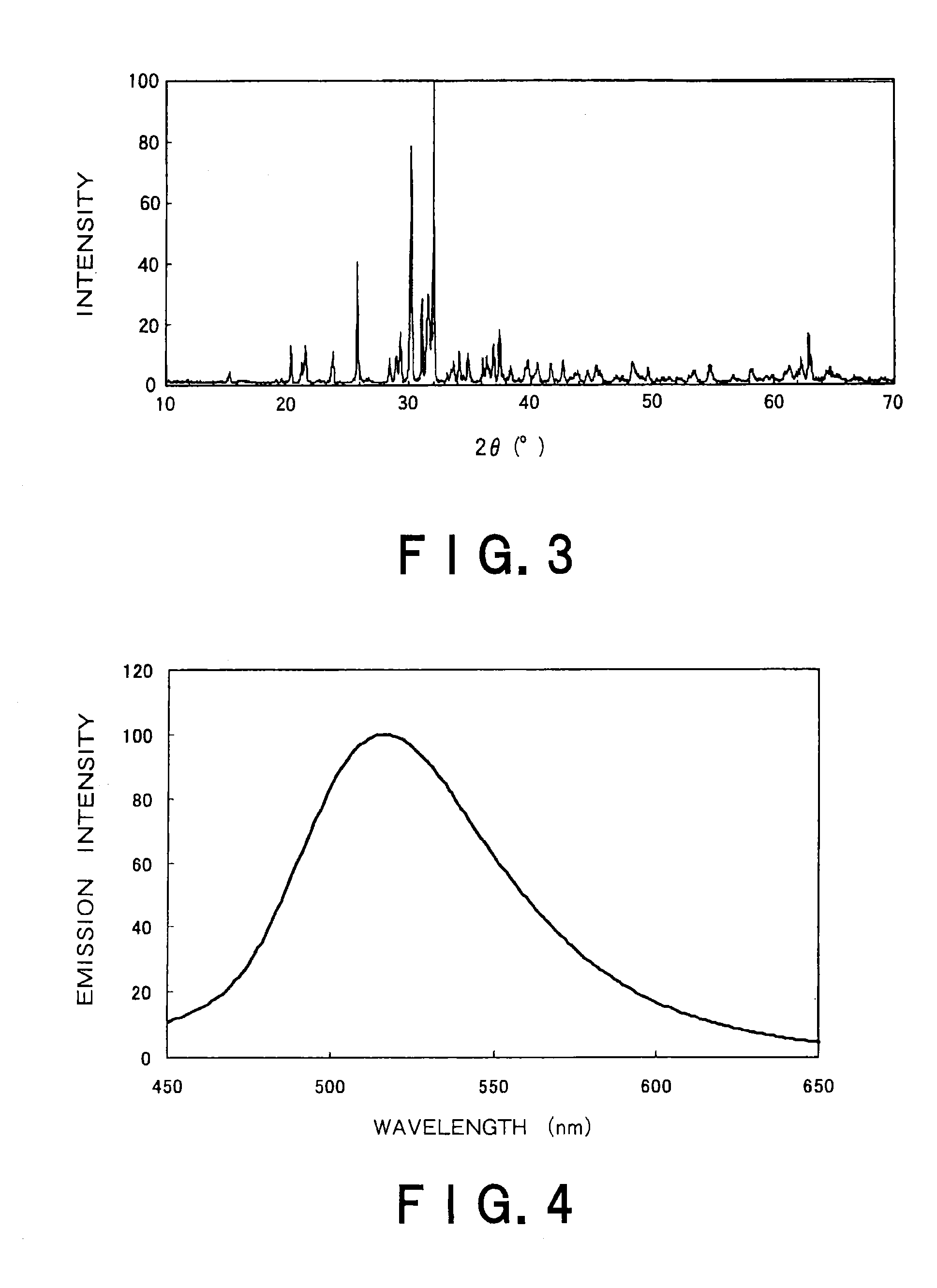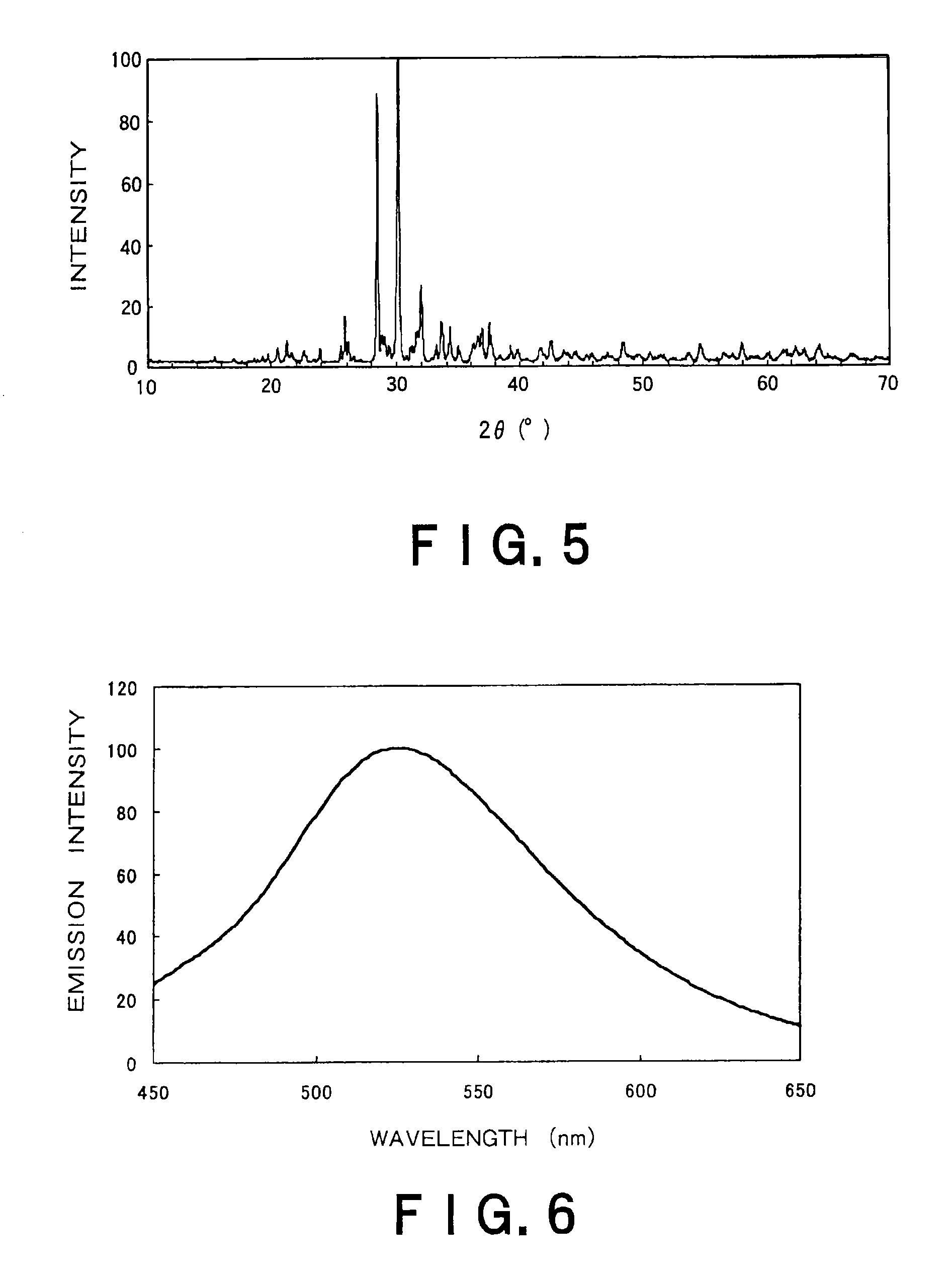Process for production of fluorescent substance
a technology of oxynitride and fluorescent substances, which is applied in the direction of luminescent compositions, chemistry apparatus and processes, inorganic chemistry, etc., can solve the problems of forming a considerable amount of by-products, chemically unstable, and easy decomposition in air
- Summary
- Abstract
- Description
- Claims
- Application Information
AI Technical Summary
Benefits of technology
Problems solved by technology
Method used
Image
Examples
example 1
[0055]As the starting materials, SrO, Eu2O3 and Si powder in the amounts of 7.46 g, 1.41 g and 5.62 g, respectively, were weighed out and dry-mixed. In the obtained mixture, the composition ratio (molar ratio) of the elements Sr:Eu:Si was 1.8:0.2:5.0. The mixture was placed in a BN container and then fired at 1500° C. for 8 hours under atmospheric pressure in a reductive atmosphere in which flow rates of H2 and N2 were 5 L / min. and 5 L / min., respectively, to obtain an intermediate product in the first step. The intermediate product emitted orange luminescence having a peak at about 650 nm when excited by UV light at 365 nm. The observed emission spectrum was shown in FIG. 1. Further, the intermediate product was subjected to X-ray diffraction measurement by use of Cu—Ka line, to obtain a diffraction pattern shown in FIG. 2. The diffraction pattern had many diffraction lines corresponding to lines of the pattern shown in Xie et al., Chem. Mater. 18, 5578(2006), and therefore it was v...
example 2
[0057]As the starting materials, SrO, Eu2O3 and Si3N4 in the amounts of 9.33 g, 1.76 g and 4.68 g, respectively, were weighed out and dry-mixed. In the obtained mixture, the composition ratio (molar ratio) of the elements Sr:Eu:Si was 0.9:0.1:1.0. The mixture was placed in a SiC-made container and then fired at 1400° C. for 8 hours under atmospheric pressure in a reductive atmosphere in which flow rates of H2 and N2 were 5 L / min. and 5 L / min., respectively, to obtain an intermediate product in the first step. The intermediate product emitted orange luminescence having a peak at about 640 nm when excited by UV light at 365 nm. Further, the intermediate product was subjected to X-ray diffraction measurement, and thereby verified to contain a component represented by (Sr,Eu)2Si5N8. The intermediate product was then subjected to composition analysis, to measure the ratio by mole of oxygen to the sum of strontium and europium. As a result, the ratio was found to be 0.73, and thereby it w...
examples 3 and 4
[0059]As the starting materials, Sr(OH)2, Eu2O3 and Si powder in the amounts of 10.95 g, 1.76 g and 5.62 g, respectively, were weighed out and dry-mixed. In the obtained mixture, the composition ratio (molar ratio) of the elements Sr:Eu:Si was 0.9:0.1:2.0. The mixture was placed in a BN container and then fired at 1600° C. for 8 hours under atmospheric pressure in a reductive atmosphere in which flow rates of H2 and N2 were 5 L / min. and 5 L / min., respectively, to obtain an intermediate product in the first step. The intermediate product emitted yellowish orange luminescence having a peak at about 650 nm when excited by UV light at 365 nm. Further, the intermediate product was subjected to X-ray diffraction measurement, and thereby verified to contain a component represented by (Sr,Eu)2Si5N8. The intermediate product was then subjected to composition analysis, to measure the ratio by mole of oxygen to the sum of strontium and europium. As a result, the ratio was found to be 0.34, and...
PUM
 Login to View More
Login to View More Abstract
Description
Claims
Application Information
 Login to View More
Login to View More - R&D
- Intellectual Property
- Life Sciences
- Materials
- Tech Scout
- Unparalleled Data Quality
- Higher Quality Content
- 60% Fewer Hallucinations
Browse by: Latest US Patents, China's latest patents, Technical Efficacy Thesaurus, Application Domain, Technology Topic, Popular Technical Reports.
© 2025 PatSnap. All rights reserved.Legal|Privacy policy|Modern Slavery Act Transparency Statement|Sitemap|About US| Contact US: help@patsnap.com



